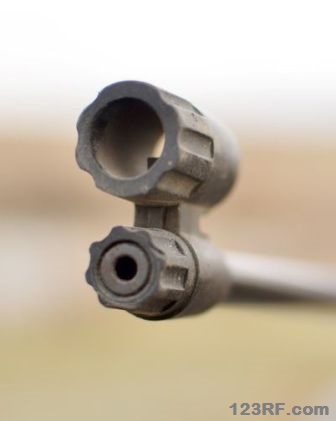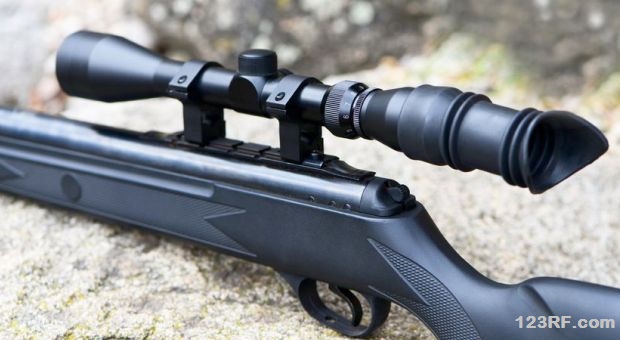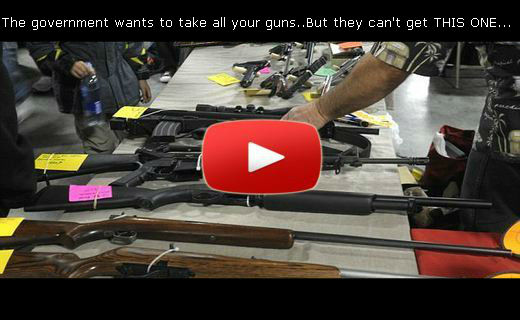Does the air rifle have its place in today’s modern survival weapons cache, or is it of use only to those that want to shoot holes in paper or hit tin cans?
 I believe that today’s air rifles do have their place in a modern survival weapons cache. This weapon can be used in small game hunting to hunt doves and other birds, rabbits, squirrel, and other small game animals.
I believe that today’s air rifles do have their place in a modern survival weapons cache. This weapon can be used in small game hunting to hunt doves and other birds, rabbits, squirrel, and other small game animals.
There is also historical evidence that air rifles were used for a number of purposes. For example, the Girandon was used during the Lewis and Clark Expedition around 1780‘s. It held 22 rounds of 40 caliber bullets in a bullet reservoir.
Related: 6 Calibers That Fly Under The Prepper Radar
This weapon had to be pumped over 1200 times to supply the air pressure needed to fire all the bullets one at a time. The bullet velocity of this weapon was equal to black powder rifles of this period (450-650fps).
Why Should You Use an Air Gun?
Here are some advantages associated with using an air rifle:
- Air rifles are very quiet – there are no loud bangs to scare off other game in the area.
- Easy to shoot – this weapon points nicely, and is not too heavy or large for the beginner or inexperienced shooter.
- It is an excellent, low cost training rifle with a simple design and cheap pellets.
- Air rifles come with iron sights and are very accurate. When used with a scope, the shooter gets very tight groups (where multiple pellets hit). When hunting with a scoped air rifle, small game may be taken safely up to 50 yards away.
- They are legal to own and shoot in most states. Because an air rifle uses only compressed air to fire the pellet (and not powder and a primer) most states do not classify them as firearms.
- Air rifles make an ideal stash gun. It can be buried in an air and water tight container with a couple of tins of pellets and then easily retrieved at a later time.
- Ammunition will not go bad. The only ammunition an air rifle needs is a pellet, nothing else. There are no cases, powder, or primers to worry about.
Basic Air Rifle Power Systems and Designs
There are three basic power systems in modern air rifles:
- Spring and Piston: When the rifle is cocked a spring is compressed. When the trigger is pulled, the released spring pushes a piston forward that, in turn, compresses a column of air that fires the pellet out of the barrel.
- Air Cartridge/Tank: This system uses a pre-filled, high pressure air cartridge or air tanks to push the pellet out of the barrel when fired.
- Air Pump: The air pump system allows the shooter to pump up the air reservoir to the desired air pressure. Some rifles need only one pump to fill the reservoir while others may need six or more.
In today’s air rifle marketplace there are many types of rifles:
- Some just fire BB’s and are considered by some to be nothing more than toys (ex. Daisy Rough Rider with its low velocity and short range).
- Some air rifles can shoot both BB’s and pellets. The Crossman Air Rifle had a little higher velocity and a little better range with pellets. These rifles are considered by most shooters to be training rifles.
- Competition rifles are very accurate and can shoot very tight groups at the competition range of 15 yards with “iron” match sights.
- Hunting rifles such as the Gamo Silent Cat (1250 fps) can be used for small game. Depending on the caliber and the pellet weight the velocity must be at least 650fps to about 1250fps to have enough energy to kill.
Things to Consider When Choosing an Air Rifle
Caliber: There are three basic calibers for air rifles.
- .177 is a small, light, and very fast with top out velocity of 1250 fps. It is used mainly for target practice, competition shooting, and small game hunting.
- 20 caliber – This is the medium weight caliber with velocities around 850fps to 1000fps. This is not a very popular caliber in the US and obtaining pellets and other shooting equipment can be difficult.
- 22 caliber – This is the largest caliber and fires the heaviest pellet for air rifles. The velocities of this rifle range between 650fps to 1250fps. It is usually used for hunting and practice.
Air Source: Even though pre-filled canisters can give you good velocity in the beginning, their power will decrease after just a few shots. In a crisis scenario, you will not be able to refill smaller CO2 canisters, and larger ones will require a compressor and pump.
Unfortunately, springs do not supply the kind of velocity you will get from a canister/ air tank system.
Most people would say that pump systems offer the best choice because you do not need canisters, and yet they still offer good velocity.
Regardless of the air source, test out your rifle at different temperatures so that you understand how rifle cooling and air temperatures affect both pellet velocity and capacity to fire multiple rounds.
Selecting an Air Rifle for Hunting
When selecting an air rifle for this purpose, it is important to think about the kind of game that you will be hunting.
Usually, you can hunt rabbit, squirrel, or birds with a .177 or a 22. If you are going to hunt for larger animals such as raccoons, you will need heavier pellets such as the 22. In order to kill game efficiently, the pellet velocity must not go below 650 fps.
- Type of air source: Will the rifle use spring piston, compressed air tank, or pump.
- What type of accessories are needed on the rifle: For precision small game hunting a fixed power scope(4x32mm) would be a good choice.
- How easy to get ammo: Before the time of a crisis both .177 and .22 caliber ammo will be easy to obtain. A tin of .177 pellets on the average will cost about $8.99 per 250 (all-purpose pellets). A tin of .22 caliber pellets will run about $8.99 per 175 pellets.
- Price of an air rifle: The average price for a.177 air rifle is about $160.00. The average price for a .22 air rifle is about $200.00.
Most air rifle hunter’s use either .177 or .22 caliber models. You can also get air rifles with combination barrel sets that include .177 and a .22, that screw into a stock mounted barrel holder.
Related: Top 5 Ammo Types for Your Survival Guns
Accuracy in these 2 barrel sets is excellent and the price is low. I would recommend the Beeman Grizyly Dual caliber to fellow preppers priced at about $129.00. It is truly the best of 2 worlds.
Storing Air Rifles for Survival
 When a major crisis hits, you will need a very quiet and accurate small game hunting air rifle. It does not take much time or materials to build a stash container for this type of rifle.
When a major crisis hits, you will need a very quiet and accurate small game hunting air rifle. It does not take much time or materials to build a stash container for this type of rifle.
All that is required is a piece of PVC piping a couple of inches longer than the rifle and 2 end caps. In this container you can place the air rifle, a couple of tins of pellets, and a cleaning kit to keep your air rifle clean and well lubricated.
Lastly hide the stash tube in one of your hiding places.
Safety Concerns
When shooting an air rifle safety should be always on your mind.
- Know what is behind your target area
- Use pellet traps down range to stop the fired pellets during rifle practice
- Wear shooting safety glasses when shooting. If you wear prescription glasses, make sure your shooting glasses cover them.
- Do not pick up or shoot your air rifle when other people are down range
- No horse play on the range during shooting practice
- Do not put the wrong size pellet in your air rifle
When picking out weapons for survival do not forget to choose an air rifle. These inexpensive yet very accurate and low noise weapons are a must. Ammunition is cheap, plentiful and you do not have to be concerned with ammunition break down.
As an added bonus, if you cannot obtain a conventional firearm, at least having an air rifle on hand will be better than nothing.
by Fred Tyrell





